Discover Florida Nature
It's time to explore the natural Florida


|
|
|
|
|
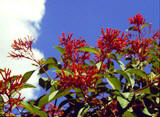 Firebush
(Hamelia patens)- Firebush...the name says it all! This tropical shrub
is known for two attributes. First, the plant shows colors that would
make any blaze proud. And second, it's the only plant that I know which
actually performs better the closer it gets to spontaneous combustion!
The firebush hails from the gulf states of Mexico, South Florida, the
West Indies, and Central and South America. In its native habitat,
Firebush is known more for its herbal properties than for its ornamental
value. The small black fruit is considered acidic and edible, and a
fermented drink is supposedly prepared from it. The leaves and stems
have been used for tanning. The crushed leaves are sometimes applied to
cuts and bruises, and the crushed leaves with vinegar are applied to
eruptions of the skin. The plant is also used for washes and for lotions
to relieve swelling of the legs and to deodorize them. A syrup from the
fruit has reportedly been used in the West Indies as a remedy for
dysentery. Firebush
(Hamelia patens)- Firebush...the name says it all! This tropical shrub
is known for two attributes. First, the plant shows colors that would
make any blaze proud. And second, it's the only plant that I know which
actually performs better the closer it gets to spontaneous combustion!
The firebush hails from the gulf states of Mexico, South Florida, the
West Indies, and Central and South America. In its native habitat,
Firebush is known more for its herbal properties than for its ornamental
value. The small black fruit is considered acidic and edible, and a
fermented drink is supposedly prepared from it. The leaves and stems
have been used for tanning. The crushed leaves are sometimes applied to
cuts and bruises, and the crushed leaves with vinegar are applied to
eruptions of the skin. The plant is also used for washes and for lotions
to relieve swelling of the legs and to deodorize them. A syrup from the
fruit has reportedly been used in the West Indies as a remedy for
dysentery.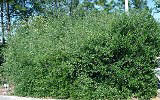 Florida
Swamp Privet (Forestiera segregata)- Swamp privets are large
shrubs or small trees that are native to the state of Florida. They grow
15-25 feet tall and have diamond-shaped leaves that are green-yellowish
above and paler below. The bark is dark brown, thin and smooth. The
flowers are tiny and greenish-yellow in color. They form small clusters
in early spring before leaves appear. Male and female flowers are on
separate plants. The fruit is 3/8-5/8 inch long, narrowly oblong, and
dark purplish to black in color. The Florida privet in this family is an
evergreen. Both species are found in wet soils bordering streams,
swamps, and lakes. The plants are used for erosion control and the fruit
is consumed by wild ducks. Florida
Swamp Privet (Forestiera segregata)- Swamp privets are large
shrubs or small trees that are native to the state of Florida. They grow
15-25 feet tall and have diamond-shaped leaves that are green-yellowish
above and paler below. The bark is dark brown, thin and smooth. The
flowers are tiny and greenish-yellow in color. They form small clusters
in early spring before leaves appear. Male and female flowers are on
separate plants. The fruit is 3/8-5/8 inch long, narrowly oblong, and
dark purplish to black in color. The Florida privet in this family is an
evergreen. Both species are found in wet soils bordering streams,
swamps, and lakes. The plants are used for erosion control and the fruit
is consumed by wild ducks.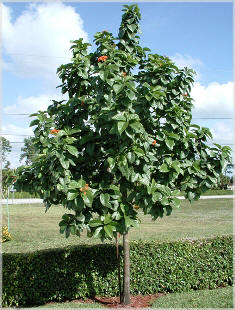 Geiger
Tree (Cordia sebestena)- Also known as the orange geiger tree,
the geiger tree is a small shapely tree which grows up to be 25" tall
and as wide. It is native to the northern coast of South America,
Yucatan, the West Indies, and the Florida Keys. Named after Captain
John H. Geiger, who built his home on Whitehead Street in Key West, the
name "Geiger tree" is likely of local origin inspired by Audubon's
engraving of Captain Geiger's beautiful flowering Cordia tree with
white-crowned pigeons sitting in a branch. Audubon's assistant, George
Lehman painted the Geiger tree. The large, 7" long, stiff, dark green
leaves are rough and hairy and feel somewhat like sandpaper. An ideal
tree for difficult plant soils, the geiger tree is both high drought
tolerant and high flood tolerant! Geiger
Tree (Cordia sebestena)- Also known as the orange geiger tree,
the geiger tree is a small shapely tree which grows up to be 25" tall
and as wide. It is native to the northern coast of South America,
Yucatan, the West Indies, and the Florida Keys. Named after Captain
John H. Geiger, who built his home on Whitehead Street in Key West, the
name "Geiger tree" is likely of local origin inspired by Audubon's
engraving of Captain Geiger's beautiful flowering Cordia tree with
white-crowned pigeons sitting in a branch. Audubon's assistant, George
Lehman painted the Geiger tree. The large, 7" long, stiff, dark green
leaves are rough and hairy and feel somewhat like sandpaper. An ideal
tree for difficult plant soils, the geiger tree is both high drought
tolerant and high flood tolerant!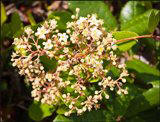 Gopher
Apple (Licania michauxii)- Technically a shrub, gopher apple
looks more like a bunch of oak seedlings or some kind of weird
leather-fern ground cover. It grows with an extensive maze of
underground stems that send up slender woody shoots with evergreen
oak-like leaves. The leaves are stiff, simple, alternate, elliptic, and
about 2-4 inches long and 1 inch wide. The leaves rise only about a foot
or so above ground, but a single clonal plant can easily spread its
subterranean stems and branches over more than 100 square feet. The
flowers don't look anything like oak catkins. They are small, yellowish,
and clustered in 4 inch triangular shaped terminal cymes that stand a
little above the leaves. The fruits are green at first, turning dirty
white when ripe, and about an inch long. The Gopher apple grows wild in
dry pinelands, sandy roadsides, and coastal dunes on the southeastern
coastal plain from South Carolina to Florida and west to Louisiana. Gopher
Apple (Licania michauxii)- Technically a shrub, gopher apple
looks more like a bunch of oak seedlings or some kind of weird
leather-fern ground cover. It grows with an extensive maze of
underground stems that send up slender woody shoots with evergreen
oak-like leaves. The leaves are stiff, simple, alternate, elliptic, and
about 2-4 inches long and 1 inch wide. The leaves rise only about a foot
or so above ground, but a single clonal plant can easily spread its
subterranean stems and branches over more than 100 square feet. The
flowers don't look anything like oak catkins. They are small, yellowish,
and clustered in 4 inch triangular shaped terminal cymes that stand a
little above the leaves. The fruits are green at first, turning dirty
white when ripe, and about an inch long. The Gopher apple grows wild in
dry pinelands, sandy roadsides, and coastal dunes on the southeastern
coastal plain from South Carolina to Florida and west to Louisiana.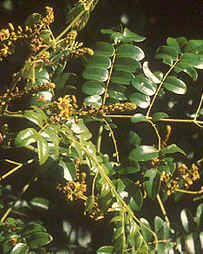 Gray
Nicker (Caesalpinia bonduc L) - Gray nicker is a native vine of
Florida's central and southern coastal dunes. It blooms summer through
fall. Plants are erect or spreading and vine-like. If erect in habit,
it may attain a height of approximately 4 feet; if reclining or
spreading, and using other vegetation for support, its stems may grow as
much as 18 - 20 feet in length. Sharp spines cover the stems, which may
grow to 2 or more inches in diameter. Leaves are shiny, opposite and
compound, with 4-5 pairs of bipinnate leaflets, each 2 - 2.5 inches in
length. Yellow, 5-petaled flowers occur year-round in clusters on leaf
axils. Flowers are typically 1 inch wide when in full bloom. Fruits
grow in spiny, flattened pods, 4 inches in length. Two or three smooth,
hard seeds, 1 inch in length, are contained in each pod. Seeds inside
pods are olive green in color, but as the pods dry to a dark red-brown
color, they open and release the seeds, which then bleach in the sun to
a dull gray color. Gray
Nicker (Caesalpinia bonduc L) - Gray nicker is a native vine of
Florida's central and southern coastal dunes. It blooms summer through
fall. Plants are erect or spreading and vine-like. If erect in habit,
it may attain a height of approximately 4 feet; if reclining or
spreading, and using other vegetation for support, its stems may grow as
much as 18 - 20 feet in length. Sharp spines cover the stems, which may
grow to 2 or more inches in diameter. Leaves are shiny, opposite and
compound, with 4-5 pairs of bipinnate leaflets, each 2 - 2.5 inches in
length. Yellow, 5-petaled flowers occur year-round in clusters on leaf
axils. Flowers are typically 1 inch wide when in full bloom. Fruits
grow in spiny, flattened pods, 4 inches in length. Two or three smooth,
hard seeds, 1 inch in length, are contained in each pod. Seeds inside
pods are olive green in color, but as the pods dry to a dark red-brown
color, they open and release the seeds, which then bleach in the sun to
a dull gray color. 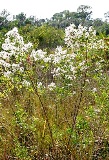 Groundsel
Tree (Baccharis halimifolia L) -A common and widespread
species in forest edges and in thickets, the groundsel tree can be
aggressive when planted, spreading readily from seed, so caution is
advisable. This Medium erect shrub or rarely a small tree has a narrow,
conical crown. The groundsel tree, often called saltbush, or sea-myrtle,
has a short trunk that gets up to 5 inches in diameter. It's leaves are
1/2 to 3 inches long, and firm. The groundsel tree has dark brown bark
with long shallow ridges. The groundsel tree's range is from the
Eastern and southeastern United States south to the Monroe County Keys,
and down to the West Indies. Groundsel
Tree (Baccharis halimifolia L) -A common and widespread
species in forest edges and in thickets, the groundsel tree can be
aggressive when planted, spreading readily from seed, so caution is
advisable. This Medium erect shrub or rarely a small tree has a narrow,
conical crown. The groundsel tree, often called saltbush, or sea-myrtle,
has a short trunk that gets up to 5 inches in diameter. It's leaves are
1/2 to 3 inches long, and firm. The groundsel tree has dark brown bark
with long shallow ridges. The groundsel tree's range is from the
Eastern and southeastern United States south to the Monroe County Keys,
and down to the West Indies.
|
|
|
Advertise | Privacy Statement | Dog Encyclopedia | Video |Contact | Alaska Nature |
|